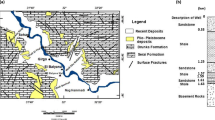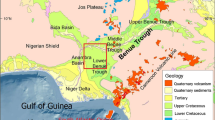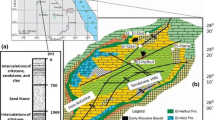Abstract
The study area lies to the south of El-Dakhla Oasis in the central part of the western desert, Egypt. It is limited by the latitudes 24–25° N and the longitudes 28–30° E. The main purpose of this work is the investigation of the subsurface structure and the delineation of the main structural elements at different subsurface levels. This study aims also to estimate the basement depth, the basement relief, and consequently, the thickness of the sedimentary cover. The study is based on acquired aeromagnetic data prepared by "La Compagnie General De Géophysique" for the Egyptian General Petroleum Company and Conoco (1977), geological information and results of previous studies in the region. The study involves the analysis for the aeromagnetic data and generating of reduced to pole magnetic map from which different magnetic maps are calculated. The calculated maps are first vertical derivative map and downward continuation map at depth level 400 m. Trend analysis technique is used to define the fault pattern affecting the studied area at different subsurface levels. It is applied to the reduced to pole magnetic map, the first vertical derivative map, and the downward continuation map at depth level 400 m of the study area. All results obtained from the interpretation process were combined together to draw the general view of the subsurface structures of the area. The NE–SW, E–W, and N–S trends are important surface and subsurface (basement) structural trends. This is attributed to the rejuvenation of movements on these old (basement) tectonic trends after the deposition of the sedimentary cover. Basement depth calculation from the aeromagnetic data is achieved using different techniques. The applied techniques included natural spectral analysis and Euler deconvolution. The depth values obtained vary from 400 to 1,700 m.












Similar content being viewed by others
References
Arcinfo v 10 (2010) ESRI, 380 New York Street, Redlands, CA 92373–8100, USA
Awad G and Ghobrial M (1965) Zonal stratigraphy of the Kharga Oasis. Geological Survey, UAR, Paper No. 34
Bakheit A (1989) Geological and geophysical studies on the areas around Wadi El-Assiuti, eastern desert, Egypt. Ph.D. Thesis, Fac.Sci.,Assiut Univ., Assiut, Egypt
Baranov V, Naudy H (1964) Numerical calculation of the formula of reduction to the magnetic pole. Geophysics 29:67–79
Barthel K, Boettcher (1978) Abu Ballas formation: a significant lithostratigraphic unit of the former Nubian Series. Mitt Bayer Staats, Paleonto LHArt Geol 18:155–166
Barthel K, Herrmann-Degen W (1981) Late Cretaceous and Early Tertiary stratigraphy in the great Sand Sea and its SE margins (Farafra and Dakhla Oasis), SW desert Egypt. Mitt Bayer Staats Paleontol Hut Geol 21:141–182
Bath M (1974) Spectral analysis in geophysics. Elsevier Scientific publ. Company, Amsterdam
Bhattacharyya B (1978) Computer modeling in gravity and magnetic interpretation. Geophys 43:912–929
Blakely RJ, Connard GC (1989) Crustal studies using magnetic data. In: Pakiser LC, Mooney WD (eds) Geophysical framework of the continental United States: Geological Society of America Memoir 172
Brown G and Colemen R (1992) The tectonic framework of the Arabian Peninsula. 24th International Geological Congress, Montreal. Proc., 3:300–305
Constantinescu L, Botezatu R (1961) A partial procedure for the downward continuation of potential fields. Rev Geol Geog 6:247–275
EGPC and Conoco (1977) Aeromagnetic anomaly map of southern Egypt; scale 1:500,000 Complied by the "La Compagnie General De Geophysique" Cairo, Egypt
EGPC and Conoco, (1987) Geological map of Egypt, Scale 1:500,000 Cairo, Egypt
El-Gaby S, List FK, Tehrani R (1987) Geology, evolution, and metallogenesis of the Pan-African Belt in Egypt. In: El-Gaby S, Greiling RO (eds) The Pan-African Belt of NE Africa and adjacent areas. Viewing and Sohn, Braunschweig, pp 17–68
El Shazly, E. M (1966) Structural development of Egypt, U.A.R., The Geol Soc. of Egypt., 4th Annual Meeting, Cairo, pp. 31–38
Fritz H, Wallbrecher E, Khudeir A, Abu Elela F, Dallmeyers D (1996) Formation of new Proterozoic, metamorphic, and complexes during oblique convergence (eastern desert Egypt). J Afr Earth Sci 23:311–329
Garson M, Krs M (1976) Geophysical and geological evidence of the relation of Red Sea transverse tectonics to ancient Fractures. Geol Soc Am Bull 87:169–181
Gay S (1972) Fundamental characteristics of aeromagnetic lineaments, their geological significance, and their significance to geology. The New Basement Tectonics, American stereo map company, Salt Lake
Geosoft Oasis Montaje, V.6.2.4 (2007) Geosoft Software for the Earth Science. Geosoft Inc, Toronto
Ghobrial M (1967) The structural geology of the Kharga Oasis. Geol. Survey and Mining research Dept., Cairo, Paper No.43
Grant FS, West GF (1965) Interpretation theory in applied geophysics. McGraw-Hill Book Company, New York
Gudmundsson G (1966) Interpretation of one dimensional magnetic anomalies by the use of Fourier transform. Geophys J R Astron Soc 12:87–97
Halsey J and Gardener W (1975) Tectonic analysis of Egypt using Earth Satellite data. A lecture delivered at the Egyptian General Petroleum Company (EGPC) in Cairo.
Hendriks F, Lugar P, Kallenbech H, Schroeder JH (1984) Stratigraphical and sedimentological framework of El-Kharga-Sinn El-Kaddab stretch (western and southern parts of the Upper Nile basin), Western Desert, Egypt. Berliner Geowiss Abh 50(A):117–151
Hermina M (1967) Geology of the northwest approaches of Kharga. Geol, Surv Egypt, Paper 44
Hermina M (1990) The surrounding of Kharaga, Dakhla, and Farafra Oases. In: Said R (ed) The geology of Egypt. Balkema, Rotterdam, pp 259–293
Hermina M, Ghobrial M, Issaw B (1961) The geology of the Dakhla area. Geol. Surv, Egypt
Hermina M, Klitzsch E, List F (1989) Stratigraphic lexicon and explanatory note to the geological map of Egypt. Conoco Inc, Cairo
João B, Valéria C (2003) 3D Euler deconvolution: theoretical basis for automatically selecting good solutions. Geophysics 68:1962–1968
Klitzsch E (1978) Geologische Bearbeitung Sudwest Agyptens. Ceol Rundschau 67:509–520
Klitzsch E (1986) Plate tectonic and cratonal geology in Northeast Africa (Egypt-Sudan). Stuttgart Geol Rdsh 75(3):753–768
Klitzsch E, Lejal-Nicol A (1984) Flora and fauna from a strata in southern Egypt and northern Sudan (Nubia and surrounding areas). DeL Geowiss Abh 50(A):47–79
MagPick Software (2006) Magnetic processing and interpretation software Version 2.83. By Mikhail Tchernychev, Geometrics Inc., USA
Meshref W (1982) Regional structural setting of northern Egypt. A symposium of the 6th Expl. Seminar, EGPC, Cairo, pp. 17–34
Meshref W (1990) Tectonic framework. In: Said R (ed) Geology of Egypt. Balkema, Amsterdam, pp 113–155
Meshref W, El-Sheikh M (1973) Magnetic tectonic trend analysis in northern Egypt. Egypt J Geol 17:179–184
Nabighian M (1972) The analytical signal of two-dimensional magnetic bodies with polynomial cross-sections; its properties and use for automate anomaly interpretation. Geophysics 37:505–517
Nettleton LL (1976) Gravity and Magnetic in oil prospecting. McGraw Hill Book Co., New York
Parasniss D (1997) Principles of applied geophysics, 5th edn. Chapman & Hall, London
Reid A, Allsop J, Granser H, Millett A, Somerton I (1990) Magnetic interpretation in three dimensions using Euler deconvolution. Geophysics 55:80–90
Reynolds J (1997) An introduction to applied and environmental geophysics. John Wiley & sons, Chester
Rockware software, ver.15, (2010) Rockware incorporation for earth science and GIS software, USA
Said R (1962) The geology of Egypt. Elsevier Publishing Co, Amsterdam-New York
Schandelmeier H, Klitsch E, Hendriks F and Wycish P (1987) Structural Development of Northeast Africa since Precambrian time, Berliner Geowiss. Abh. (A), 75 (1):5–24
NSPT Software (1984) compatibility software GW-Basic, Ver.2.02.By Phoenix software associated
Solovyev OA (1962) Use of the frequency method for the determination of some parameters of magnetic bodies. Akad Naukss Geopfizika 12:122–152
Spector A, Grant F (1970) Statistical models for interpreting aeromagnetic data. Geophysics 35:293–302
Surfer Software, 10 (2011) Surface mapping system. Golden Software Inc., Colorado, USA
Thompson D (1982) EULDPH—a new technique for making computer-assisted depth estimates from magnetic data. Geophysics 47:31–37
Valéria C, João B, Walter E (1999) Stability analysis and improvement of structural index estimation in Euler deconvolution. Geophysics 64(1):48–60
Youssef M (1959) Relation between groundwater composition and geology of Dakhla Oasis. Report of Desert institute, Cairo
Youssef M (1968) Structural pattern of Egypt and its interpretation. AAPG Bull 52:601–614
Youssef M, Ibrahim H, Bakheit A, Senosy M (1998) Tectonic pattern developed within the Sohag region, Middle Egypt. J Afr Earth Sci 26(2):327–339
Author information
Authors and Affiliations
Corresponding author
Rights and permissions
About this article
Cite this article
Bakheit, A.A., Abdel Aal, G.Z., El-Haddad, A.E. et al. Subsurface tectonic pattern and basement topography as interpreted from aeromagnetic data to the south of El-Dakhla Oasis, western desert, Egypt. Arab J Geosci 7, 2165–2178 (2014). https://doi.org/10.1007/s12517-013-0896-3
Received:
Accepted:
Published:
Issue Date:
DOI: https://doi.org/10.1007/s12517-013-0896-3




